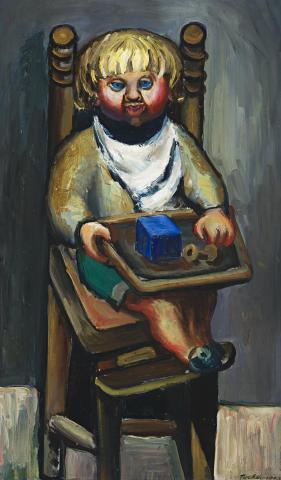SWEENEY IN HIGH CHAIR, 1946
ALBERT TUCKER
oil on composition board
76.0 x 45.0 cm
signed and dated lower right: Tucker 46
Reed Family Collection, Victoria
Albert Tucker: A Retrospective, National Gallery of Victoria, Melbourne, 1990 (label attached verso)
Mollison, J. and Minchin, J., Albert Tucker: A Retrospective, National Gallery of Victoria, Melbourne, 1990, p. 72 (illus.). 72 (illus.)
On 4 March 1945 Joy Hester gave birth to Sweeney Hallam Tucker Reed. He was named after Sweeney in Sweeney Agonistes, a poetic drama by T. S. Eliot in whom his parents had a mutual interest. He was adored, photographed and painted by his father Albert Tucker. After the breakup of Hester and Tucker's marriage in 1947, Sweeney was later adopted by John and Sunday Reed. Growing up at Heide, he was surrounded by a circle of creative people who were among the leading contemporary artists and poets of their day. His first collection of prose poems, The Savage Urge with illustrations by Mirka Mora, was published in 1962. In 1966 he opened Strines Gallery, Carlton, and developed a stable of young and adventurous artists. In the seventies, after a publishing interlude, he returned to art dealing opening the Sweeney Reed Gallery, Fitzroy. In 1972 father and son worked together to present a major exhibition of Tucker's work, Night Images (Images of Modern Evil) 1943-1947 at Reed's gallery. It was the first time these works had been shown together in such numbers. Sweeney's life ended tragically with his suicide in 1979. Tucker's 1983 portraits of his son were included in the Tolarno Galleries 1985 exhibition Faces I Have Met. Of a handsomely sensitive young man, they are a deeply moving homage, of recollection and reconciliation.
Sweeney in High Chair 1946, painted the year before Tucker and Hester separated, is full of fatherly pride and joy in his one year old son. The moment is one of child like wonderment, pausing from his toys to look with curiosity at what his father is doing with his paintbrushes and board. Chubby of face, blue eyed and crowned with blonde hair, he is so like his mother Joy Hester, who had Tucker in her thrall. (See lot 16 for portrait of Hester) Light falling from above not only gives greater definition to the facial features but also bathes the image in a special glow. The roundness of head, short hair and big almond eyes recall John Perceval's equally endearing images of children, especially the drawings Children Eating 1949 and Matthew Perceval 1950 in the collection of the National Gallery of Australia, Canberra. Tucker's portrait of Sweeney throned in his high chair is a quintessential image of a father's love for and pride in his only son.
DAVID THOMAS
